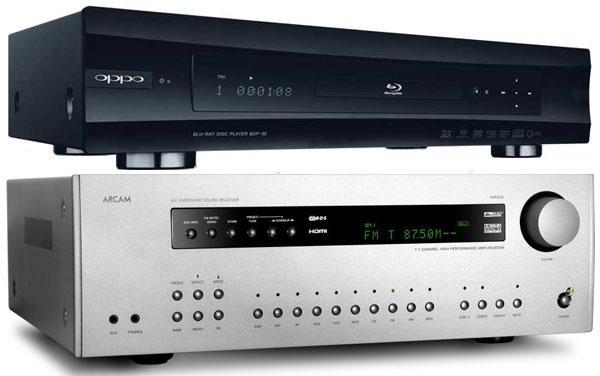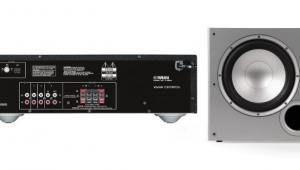With that combination of hardware, you can let the Oppo do all the decoding of the audio signals and use analog RCA connections. Beautiful!
Can I Get High-Def Via a Component Connection to My Legacy AVR?

Q I would like to use an Oppo BDP-93 as the Blu-ray player in my system connected to an Arcam AVR350 A/V receiver. Since the Arcam is a legacy AVR with no HDMI switching, I will need to use the Oppo’s component video output. Here’s my question: Will I be able to get high-definition resolution from Blu-ray discs with this setup? I have read that Blu-rays have embedded ICT (Image Constraint Token), which forces the player to downscale the video resolution to DVD quality. Also, are there any workarounds, like using an Oppo player with early (pre-ICT) firmware? —Lisa Kaye, via email
A Image Constraint Token is a key feature of the AACS digital rights management system that was created by a consortium of movie studios and technology companies to accompany the high-definition Blu-ray and HD DVD disc format launches. The idea behind ICT was to prevent the copying of high-definition digital content by plugging the “analog hole.” What typically happens is that when a Blu-ray player is connected to an HDTV using component-video cables, a flag on the disc instructs the player to downgrade the video output to 540p — a notch above DVD resolution. Having said all that, you still may be able to get high-definition images from some Blu-rays since the decision to embed ICT on the disc is up to the individual studio that produced it.
While it’s possible to find an old Blu-ray player from Oppo or another company with a firmware version that doesn’t support ICT, I’d instead suggest making a direct HDMI connection from the player to the HDTV. For an audio connection to the Arcam AVR, you could then use the player’s optical or coaxial digital outputs, or even its multichannel analog connection. Because the Arcam AVR is a legacy model that doesn’t support Dolby True HD and DTS-HD Master Audio high-res soundtrack formats, there will be no loss in using any of those audio connections. And by using an HDMI cable for a video connection to the TV, you won’t have to worry about any reduction in output resolution caused by ICT.
- Log in or register to post comments


And it worked like a charm. The quality of both video and audio are top-notch!

Your audio is NOT "top notch" if you are using a processor/AVR that can't decode DTS-HD MA & Dolby TrueHD. Of course, if you don't hear a difference between compressed digital audio and lossless digital audio, it doesn't matter to you.

I have been doubting if I should reply to your message with a short, but rather blunt answer, but decided not to. Let me explain:
you might have noticed I wrote my comment in the past tense. This means that my setup was used at a time when DTS-MA was not available and my then (and current) music library consisted of MC-SACD, redbook CD and DTS music video's. using the Oppo as a great source, using the analog 7.1 channel out into the splendid Arcam amplifier. In the meantime I have moved on with both a source and AVR that is fully up-to-date. Admittedly, not the summum in high end audio, but good enough to make me enjoy my old and new music and growing collection of bluray movie titles. Furthermore, I am a part time musician and play and visit many live concerts. Additionally I design my own high-end speakers.
So, Home Theater, I would have expected a more weighted response than presuming I can't hear the difference between compressed digital audio and lossless digital audio. It is off the mark and hurts.

It's Homer Theater (not Home). If the first comment I made "hurt" you... you must not have much experience with internet forums. This sort of stuff happens ALL the time. Read the thread from the beginning and put your brain in a mode that KEEPS VERY CLEAR, that nobody else reading your comments in the thread knows ANYTHING else about you other than just the words you posted. And learn to understand that "you" CAN mean you and only you, but it can and often does mean "all of you reading this" and then there's the use of IF... IF you use an processor/AVR that can't decode (lossless) formats, and that implies you are sending the bitstream to the AVR as there's no decoding if you send LPCM over HDMI or analog, but saying all that in a comment like this makes the comment longer than most people will read. Since you AREN'T losing any information from the audio now, that "IF" means the statement doesn't apply to you in your situation. You'll do a lot better in forums if you pay close attention to the words used and don't assume every comment is specifically for or to you. If the AVR/processor has HDMI, clearly, setting the disc player to output LPCM resolves any decoding limitations in the AVR/processor. If the AVR/processor has no HDMI, but does have 5.1 or 7.1 analog inputs, using analog connections from a disc player to an AVR/processor also escapes the issue of the AVR/processor not being able to decode lossless audio. If either of those scenarios apply to you, my original comment clearly doesn't apply to you, but could easily apply to someone else reading the thread who is still trying to get a handle on how all this stuff works.

Thank you Homer Theater (sorry) for clearing this up. The shorter post obviously had me confused. I fully agree with your elaboration.

In the past I ran my Oppo's HDMI directly to the TV and the analog audio to a stereo receiver. When I hooked up an old pre-HDMI surround sound receiver I still kept the HDMI running straight to my TV, but then used the coaxial digital output to get true 5.1 to the receiver (optical would have worked just as well but I thought the coaxial digital sounded better when I tried them both). I now have a pre-4K HDMI receiver, and I run one HDMI from my Oppo 203 4K player straight to my new 4K TV and the other HDMI right into the receiver and get the best of both worlds. I plugged the new 4K ROKU right into the HDMI input on the Oppo and now have full 5.1 HDMI audio and full 4K with HDR from both of these devices. For anyone without an Oppo and with a pre-4K HDMI enabled receiver and a 4K TV, HD FURY makes a product called AVR KEY 18GBPS that splits the audio & video apart and sends video out one HDMI jack and audio out from another. It essentially gives any 4K device 2 HDMI outputs that work exactly the way the two HDMI outputs on the Oppo work. But, make sure it is not the older AVR KEY, but the newer AVR KEY 18GBPS. The older model had real issues and the newer version has corrected them beautifully. I've hooked three of these up for friends with older receivers but new 4K TVs and they work great! I've used them with 4K ROKUs, 4K TIVOs and 4K APPLE TVs. The $150 this product costs is a lot less money than a new high quality receiver would cost.
























































